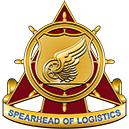Maritime Simulation Branch
The Maritime Simulations section hosts several resources which are utilized throughout our common courses as well as standalone United Stated Coast Guard (USCG) and Standards of Training and Certification for Watchkeepers (STCW) certified courses. These training resources are also available to Maritime units for training and recertification and do not require Army Training Requirements and Resource System (ATRRS) reservations. Units desiring to reserve the simulations facilities for training can submit a request through the link below.
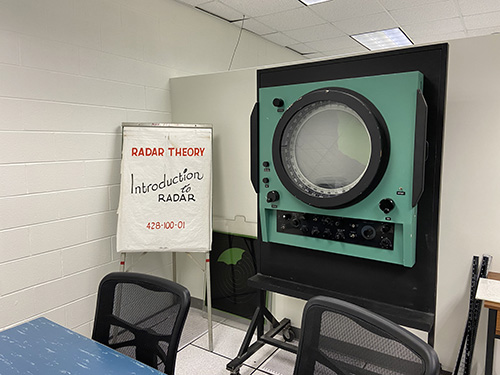
Radar/Automated Radar Plotting Aid (ARPA)
The RADAR/ARPA certification is required for successful completion of 88K30-880A1, this course is also available for standalone reservation as a refresher or for recertification. Upon completion of this course students will be issued a US Coast Guard approved Certificate of Training in “Radar Observer (Unlimited)” and “Automatic Radar Plotting Aid.”
The RADAR/ARPA certification course is required for Students attending 88K30-880A1 where Students will be required to pass (4) separate examinations demonstrating their ability apply RADAR theory in practical situation utilizing both ARPA and RADAR plotting sheets. Upon successful completion of these four (4) examinations, the student will be issued a US Coast Guard approved Certificate of Training in “Radar Observer (Unlimited)” and “Automatic Radar Plotting Aid”, and will have satisfied the IMO/STCW ARPA training requirements of AR 56-9. Units may reserve the RADAR/ARPA simulator to conduct training with their crews when these resources are available. Click on the Reservations link at the top of this page for more information on reserving these resources.
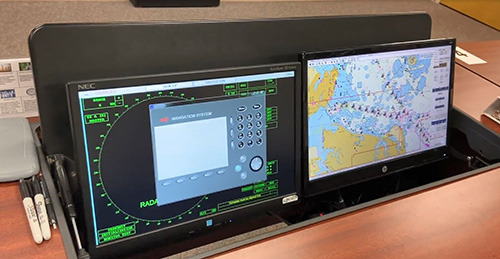
Electronic Chart Display Information System (ECDIS)
The 40-hour Electronic Chart Display and Information Systems (ECDIS) course is designed to enhance the safety of navigation by providing the knowledge and skills necessary to fully utilize ECDIS. The course incorporates live marine ECDIS equipment, networked with interactive bridge simulators. The course meets the STCW training requirements, and specific familiarization on those vessels equipped with ECDIS.
ECDIS certification is required for successful completion of 88K30-880A1, this course is also available for standalone reservation. Upon successful completion of these two (2) examinations, the student will be issued a US Coast Guard approved Certificate of Training in "Electronic Chart Display and Information System".
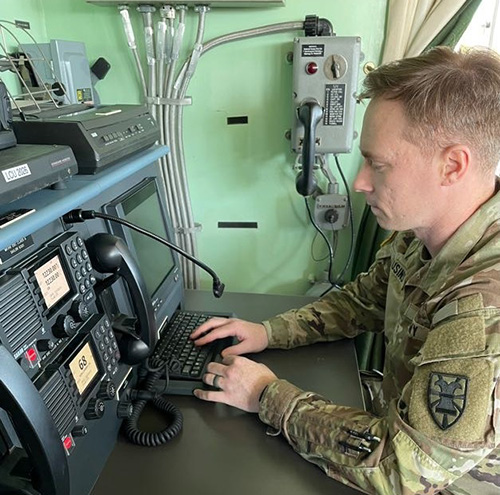
Global Maritime Distress Safety System (GMDSS)
The 80-hour Global Maritime Distress and Safety System (GMDSS) course is designed to enhance the safety of navigation by providing the knowledge and skills necessary to fully utilize the GMDSS system.
GMDSS certification is required for successful completion of 88K30-880A1, this course is also available for standalone reservation. Students will be required to pass (3) separate examinations. Element 1: Basic radio law and operating practice with which every maritime radio operator should be familiar. Element 7: GMDSS Radio Operating Practices. GMDSS radio operating procedures and practices sufficient to show detailed practical knowledge of the operation of all GMDSS sub-systems and equipment.
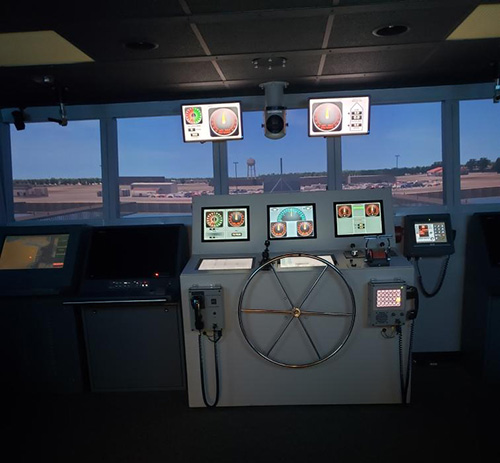
Bridge Resource Management (BRM)
This course is intended to instruct the student in the areas relevant to Bridge Resource Management and application of leadership and teamworking skills. Curriculum provides selected marine personnel, through conference and simulator-based instruction, with the skills and knowledge to operate a vessel within a complex modern marine environment. It includes managing and utilizing personnel and equipment onboard vessels in accordance with the requirements of the STCW Code. Throughout the BRM course, there will be reinforcement of applicable elements of governing doctrine as promulgated in International Maritime Organization (IMO) STCW, and the Code of Federal Regulations (CFR).
Each student who successfully completes this course will satisfy the BRM STCW, CFR training requirements and Leadership and Teamworking Skills standards of competence and receive a US Coast Guard approved Certificate of Training in “Bridge Resource Management”.
This course is open to Active Army and Reserve Component personnel in MOS 88K Watercraft Operator or 880A Marine Deck Officer assigned to or on assignment to vessels as a watch stander or watch officer on board a U.S. Army vessel. Personnel from other services and U.S. Government civilians assigned or pending assignment to positions requiring training may be accepted.
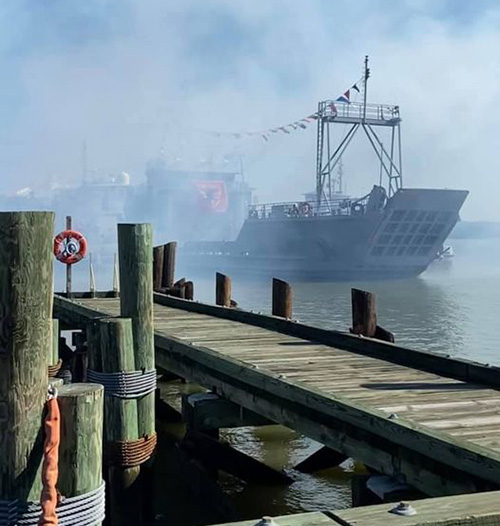
Small Mission Bridge Simulator (SMB)
The SMB Simulator provides enhanced simulation capabilities which are leveraged in the training of DoD personnel in all aspects of maritime operations to include; Navigation, Bridge Resource Management (BRM), and Ship Handling on a wide range of vessels in a variety of ports/harbors located throughout the world. The SMB is capable of integration with other devices of the Maritime Integrated Training System (MITS) for training and exercises such as Joint Logistics Over The Shore (JLOTS).
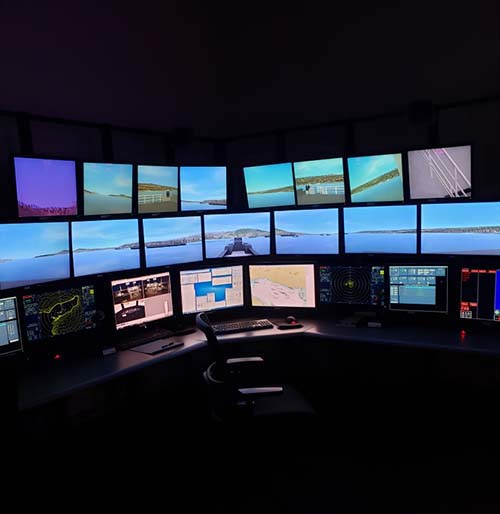
Full Mission Bridge Simulator (FMB)
The FMB Simulator provides enhanced simulation capabilities which are leveraged in the training of DoD personnel in all aspects of maritime operations to include; Navigation, Bridge Resource Management (BRM), and Ship Handling on a wide range of vessels in a variety of ports/harbors located throughout the world. The FMB is capable of integration with other devices of the Maritime Integrated Training System (MITS) for training and exercises such as Joint Logistics Over the Shore (JLOTS).
A full Mission Bridge Simulator realistically models the hydrodynamic performance of Army watercraft including 2000 series Landing Craft Utility (LCU 2000), Logistics Support Vessel (LSV), 128-foot Large Tug, Navy and Military Sea Lift vessels. This will allow student to test their skills and knowledge in all aspects including ship-handling operations, port familiarization, vessel anchoring procedures, duties as a harbor pilot, bridge resource management and leadership and teamworking skills.
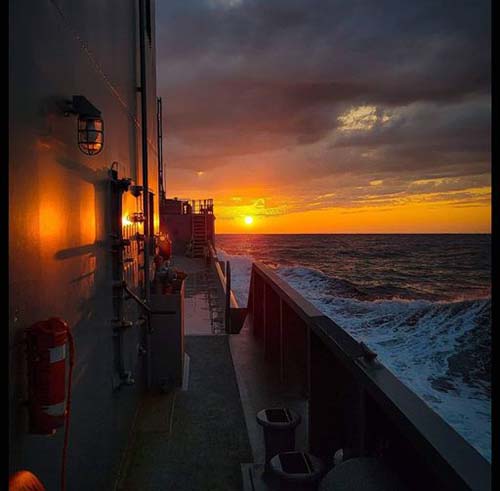
Expeditionary Fast Transport (EFT)
The EPF Simulator provides High Speed Craft (HSC) bridge operations training in the areas of Bridge Resource Management (BRM) and Advanced Ship Handling for Military Sealift Command (MSC) personnel. Capable of varying levels of complex training scenarios through integration with other devices of the Maritime Integrated Training System (MITS).
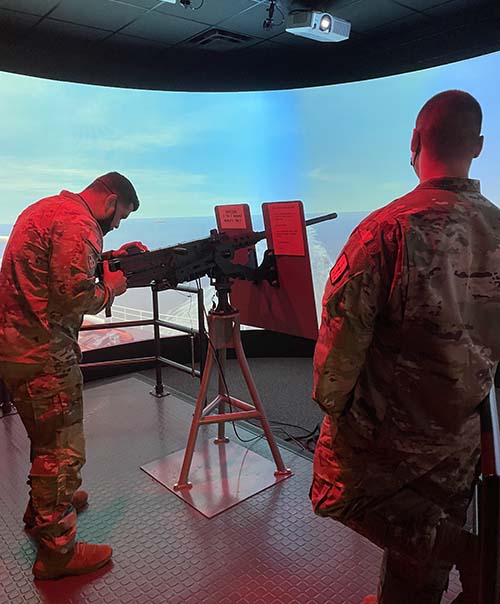
Vessel Defense Simulator (VDS)
The VDS provides replication of the form, fit, function and performance of the M2, Mk19, M240B and M4 weapon systems along with generating realistic video and sound to facilitate real world based scenario training for all aspects of Maritime and Vessel Security for DoD personnel. The VDS offers enhanced Command and Control training through integration with all devices of the Maritime Integrated Training System (MITS). Utilized for Vessel Security Officer (VSO) STCW certification and mandated as part of the crew training strategy for vessel defense leading up to the crew’s sea-based qualification.
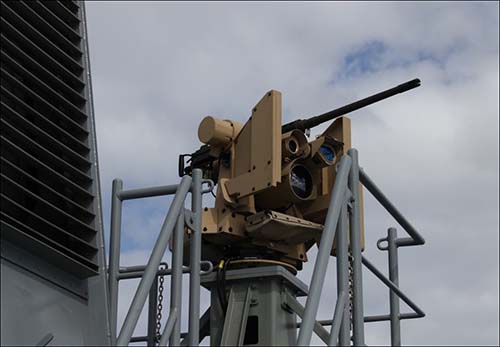
CROWS
The Common Remotely Operated Weapon Station (CROWS) Course is utilized to familiarize the U.S. Army Mariner with the M153 CROWS, and its operation. CROWS is a gunner-operated system that provides the capability to remotely aim and fire the MK19 Grenade Machine Gun (GMG), M2 Machine Gun, M240 Machine Gun, or the M249 Machine Gun from a stationary platform or while on-the-move. The M153 CROWS consists of weapons cradles, traverse and elevation drives, weapon interface, weapon remote charger, ammunition container and feed system, laser range finder, day/night viewing and sighting unit, joystick, and remote fire control and display unit.
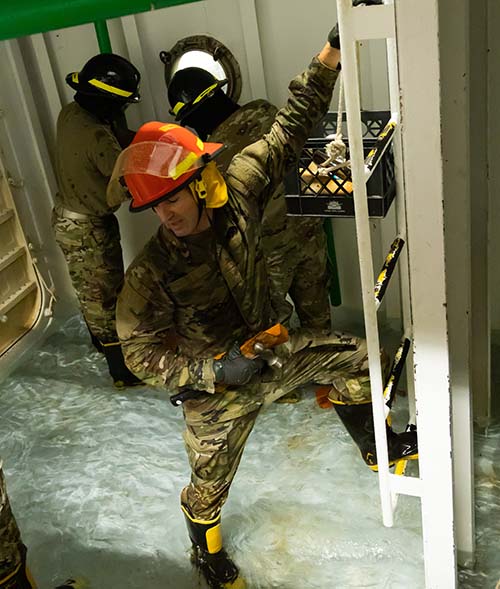
Damage Control Tank
The Damage Control tank simulates a sinking vessel or flooded compartment. Teaching students to adapt and work under stress to repair broken or damaged bulkheads, pipes, hull fractures and warped hatches. Students attending 88K and 88L courses as well as WOBC students will complete a hands-on performance exam reducing the flow of water to a sustainable percentage. Units may also reserve this resource to conduct Leaders Time Training (LTT) or crew proficiency training. Click on the Course Reservation link at the top of the page for more information.
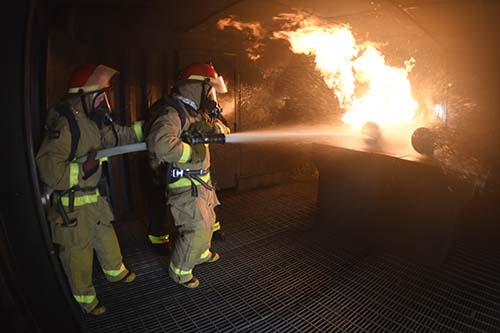
Basic and Advanced Shipboard Firefighting Trainer
This course of instruction is designed to provide to the student a training experience that combines formal classroom instruction with practical exercises and hands-on basic and advanced shipboard firefighting procedures and tactics practical training and assessment. Each student who successfully completes this course will satisfy the basic and advanced shipboard firefighting requirements of the STCW code and CFR and receive a US Coast Guard approved Certificate of Training.
This course is open to Active Army and Reserve Component personnel in MOS 88K, 88L, 880A or 881A assigned to or on assignment to vessels as a watchstander or watch officer on board a U.S. Army vessel. Personnel from other services and U.S. Government civilians assigned or pending assignment to positions requiring training may be accepted.
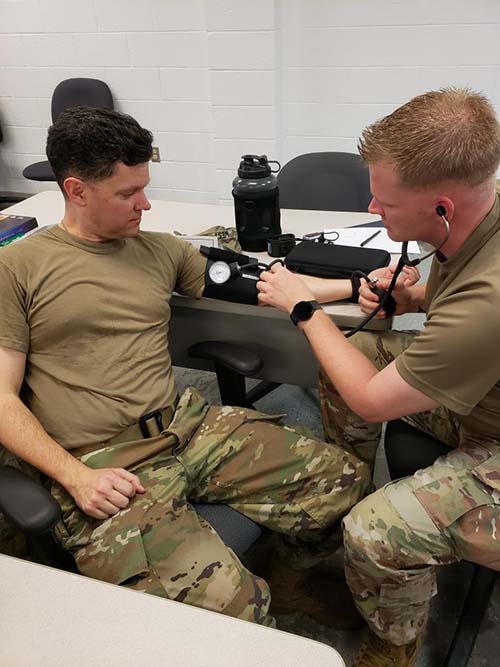
Medical Care Provider
The Medical Care Provider Course is a comprehensive program aimed at providing the needed training for candidates to provide medical care to the sick and injured onboard US Army Vessels, in accordance with Section A-VI/4 of the STCW Code. Included in this module is one T2COM standardized written examination and practical hands-on examinations.
The overarching objective is to train selected Warrant Officers, Enlisted, and Civil Service employees on meeting the minimum standard of competence in medical care, a trainee will be competent to participate effectively in co-ordinate schemes for medical assistance on ships at sea and to provide the sick or injured with a satisfactory standard of medical care while they remain onboard. This particular course contributes to the safe and effective operation US Army Watercraft throughout the various Areas of Operations (AORs).
Each student who successfully completes this course will satisfy the Medical Care Provider requirements of the STCW code and CFR and receive a US Coast Guard approved Certificate of Training.
This course is open to the following personnel who may be designated to be in charge of medical care onboard a United States Army Vessel. Active Army, Reserve Component, or National Guard Warrant Officer (WO) and qualified in MOS 880A. Active Army, Reserve Component, or National Guard Enlisted personnel and qualified in MOS 88K. Any civilian or contractor of the Department of the Army or Air Force that is assigned to a related maritime support position. These personnel shall have completed a certified CPR and First Aid course prior to this course.
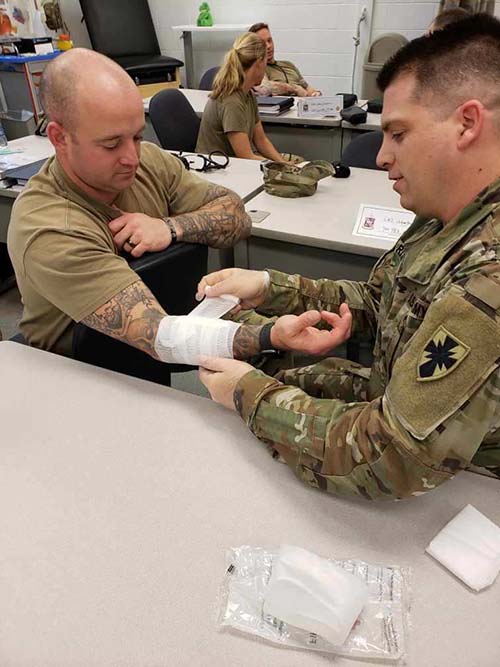
Medical Care Person in Charge
This course is intended satisfy the Medical Care Person in Charge training requirements aimed at providing the needed training for candidates designated to take charge of medical care for the sick and injured onboard US Army vessels.
This course covers the requirements of the STCW Convention as amended Chapter VI, Section A-VI/4, and Table A-VI/4-2. On meeting the minimum standard of competence in medical care, a trainee will be competent to participate effectively in coordinated schemes for medical assistance on ships at sea and to provide the sick or injured with a satisfactory standard of medical care while they remain onboard.
Each student who successfully completes this course will satisfy the Medical Care Person in Charge requirements of the STCW code and CFR and receive a US Coast Guard approved Certificate of Training.
This course is open to the following personnel who may be designated to be in charge of medical care onboard a United States Army Vessel. Active Army and Reserve Component personnel in MOS 88K, 88L, 880A or 881A assigned to or on assignment to vessels as a watchstander or watch officer on board a U.S. Army vessel. Personnel from other services and U.S. Government civilians assigned or pending assignment to positions requiring training may be accepted. These personnel shall have completed a certified CPR and First Aid and Medical Care Provider courses within six months to this course.
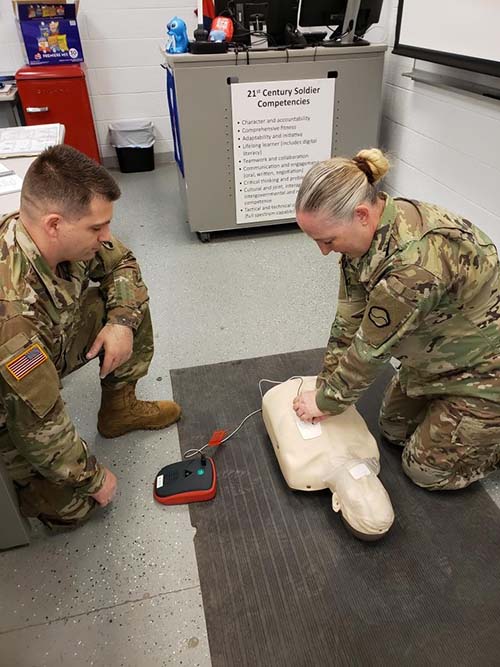
1ST AID & CPR
This course is designed to provide to the student a training experience that combines formal classroom instruction with practical exercises and hands-on first aid and CPR training and assessment. The 1st Aid & CPR Course is intended to satisfy the Basic Safety - Elementary First Aid competencies of Section A-Vl/1 and Table A-Vl/1-3 of the STCW Code, as amended, and 46 CFR I 1.302(a)(3); AND if presented within one year of the date of training, the First Aid & CPR training requirements of 46 CFR 12.602(a)(3) and 11.201 (i) for original issuance of an officer endorsement.
Each student who successfully completes this course will satisfy the 1st Aid & CPR requirements of the STCW code and CFR and receive a US Coast Guard approved Certificate of Training.
